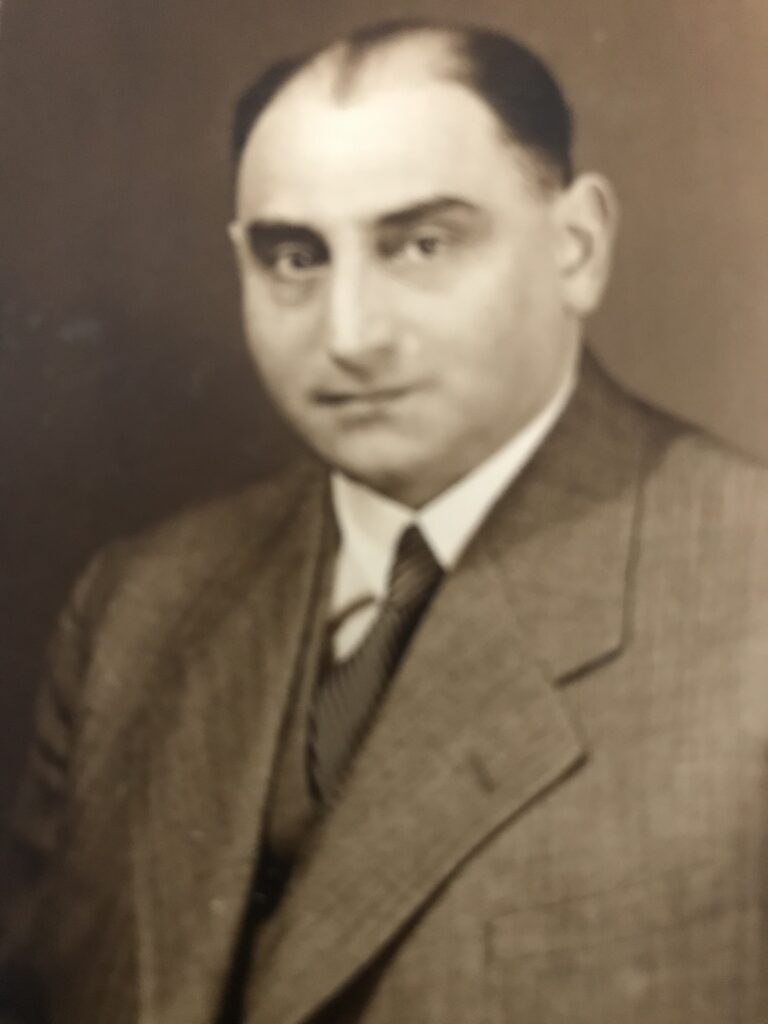
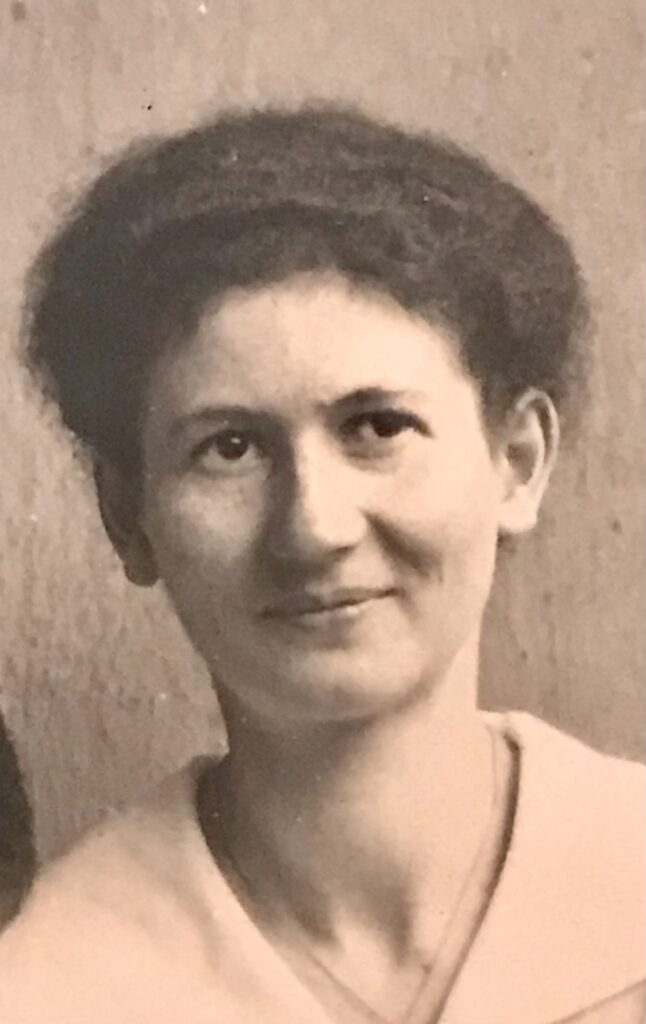
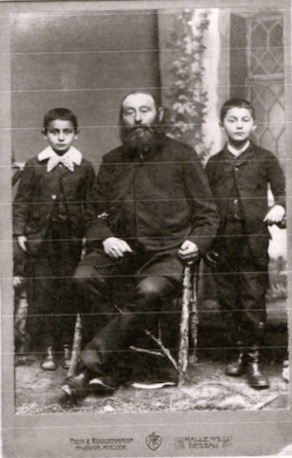
Siegmund Gassenheimer was the youngest child & son of Samuel (1837-1892) and Lotte (née Stein) Gassenheimer. Born on 15 October 1882 in the small city of Themar, he grew up in a lively Jewish community. The photo, dated 1888, shows him with his brother Rudolf, b. 1880, and father Samuel. A year later, Lotte Gassenheimer, Siegmund’s mother died; then in 1892, Samuel died; Siegmund, age 10, “was largely brought up by his older siblings,” most likely his older sisters, 20-year-old Minna (b. 1872) for the first years before her marriage to Nathan Frankenberg and move to Coburg, and then by Elise, b. 1876.
As a young man, Siegmund became part of the family business of making, selling, and repairing agricultural machinery. When exactly he moved to Dresden is not known; the Handelsregister/Commercial Register of Dresden has an entry for Siegmund Gassenheimer in 1899 when he would have been 17 years old; what that means is unclear. His 1910 marriage certificate (below) tells us that he was living in Hoyerswerda, a town in Saxony about 70 km northeast of Dresden. The first entry in the Dresden Adressbücher is in 1911.
Life changed with his marriage to Amalia Lewy, known as “Mally” to family and friends. Amalia was born in the town of Neutomischel in the province of Posen in Prussia (now Poland). Born in 1884, she was the youngest daughter of the five children of Salomon (1850-) and Johanna (née Wittkowski, 1855-1937) Lewy.
In a page of memories, Mally later wrote of her grandparents (but didn’t provided any detail about her parents). “My paternal grandfather was Josef Lewy, his wife was Malke, after whom I was named. Josef and Malke had 11 children, 5 sons and 6 daughters. My grandfather was some sort of Jewish scholar, he studied the Talmud, and left most of the household management to his wife, who was reputed to be a very resolute and dynamic woman. They lived in a village, Kirchplatz, near Neutomischel, where they ran a grocery store. Both grandparents are buried in the Jewish cemetery of Neutomischel. I often visited the graves as a child with my parents and remember that, when I read the birthdate of 1797 on my grandfather’s gravestone, was very impressed. I don’t know exactly how old they were when they died, but over 70.”
“My grandfather on my mother’s side was Samuel Wittkowski. He had learned the tailor’s trade but in later years, he became a shipping agent. These grandparents had eight children, 6 sons and 2 daughters. The relationship with the family was particularly warm, they were all closely knit. All the children were intelligent and strove for education and knowledge. That was certainly the wish of my grandfather. He was a respected man in the Jewish community and generally. Whoever needed help turned to him and he never refused. My mother told me that during the ‘Pest Epidemic’ [cholera epidemic of late 1800s?], he would be called to help the sick and the dying. My grandmother wrung her hands and said he would bring the infection into our house, but the whole family was spared. They lived in Birnbaum, which was a progressive little city in what was then the province of Posen. The place lay on the river Warthe, a side stream of the Oder. River transport of goods played a critical role then. My grandfather recruited the ships that enabled the flow of grain and other goods. Both grandparents were over 70 when they died and were buried in the Jewish cemetery of Birnbaum.”
*****
The marriage between Siegmund and Amalia took place on 13 February 1910 in Neutomischel in Posen, their marriage certificate one of the precious documents taken by Siegmund and Mally when they fled Germany in 1939.
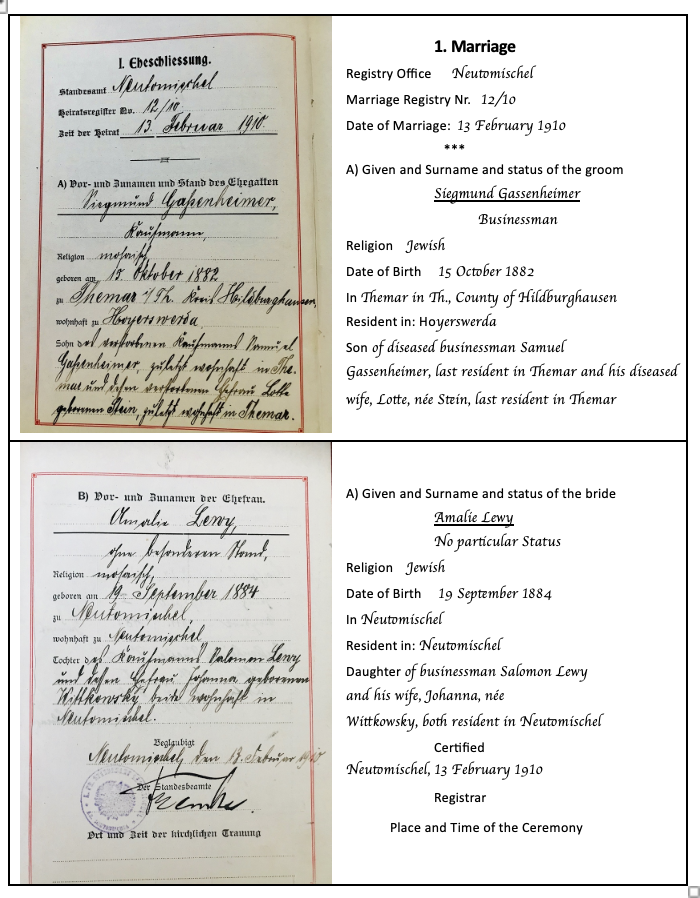
Although the marriage was “an arranged one, they were wonderfully happy,” writes their granddaughter. “I was brought up with my parents living in their house in London and they looked after me a great deal. Apparently my grandmother’s elder brothers [Georg, b. 1879, and Siegbert, b. 1882] put an advert in the paper to find a suitable husband providing her with a dowry which my grandfather needed for his agricultural machinery business.”


In April 1911, their first child, Heinz Siegbert, was born. The Gassenheimers were living at Ostbahnstrasse 11 (which no longer exists). Three years later, the Gassenheimers were living at Nürnberger Str. 22.II, and on 11 June 1914, Siegmund and Mally had a second child, this time a daughter, Ilse.
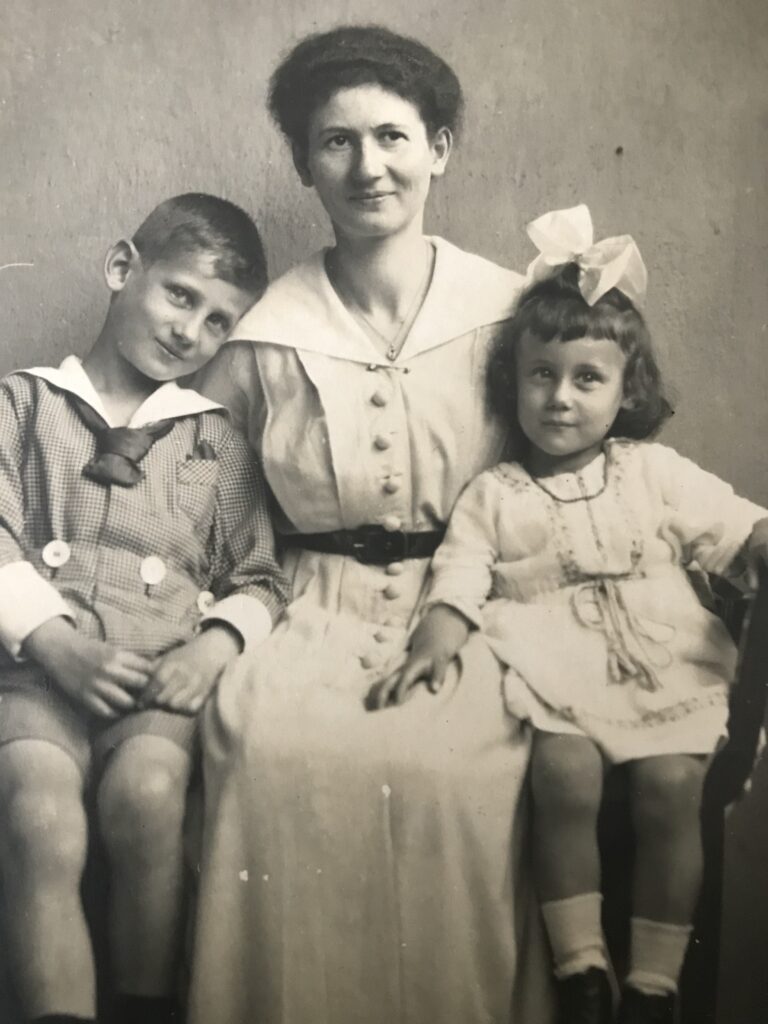
Little more than a month after Ilse’s birth, World War I began. Siegmund served in the German army ambulance core. He was the only one of his siblings to serve, probably because their ages prevented them from enlisting. Four of Siegmund’s nephews served in the German army, three sons of Siegmund’s oldest sister, Emma Marcus, and one son of Ernst. They joined the thirty (30) other men related to the Jewish families of Themar in serving their country.
*****

In 1933, the family still lived in Dresden at Nürnberger Str. 22, and there were separate entries in the Address Book for his business and residence. The granddaughter tells us how the family reacted to the Nazi party becoming the government of Germany: “Because my uncle Heinz, three years older than my mother, got beaten up at Leipzig University by anti-semites, my grandmother sent him to the London School of Economics [in 1933] for safety. From England he could see much better what was happening in Germany so, when my mother [Ilse] was 19 and by then wasn’t allowed to go to University, or the library or the swimming pool etc., Heinz encouraged her to come [to England] in 1934. My mother went back to Germany once more although [she] went through Dresden to Prague to avoid inspection of her papers. On the way back there was a check up at the border and, because her passport hadn’t been stamped on the way out, she got off the train and hid in the toilets whilst the check was taking place, then climbed out through the window and back onto the train without being seen. It was the last time she went back.”
In July 1938, Ilse Gassenheimer married Herbert Lüdicke, b. 1912 in Dresden. Herbert, a non-Jew, had left Dresden in 1935; he and Ilse knew each other from Dresden days, although they were not a couple at that time. For employment reasons, they lived apart: Ilse lived at Bedwell Park Cottages, Hatfield, Hertfordshire where she was employed as a nursery school assistant. Herbert was working as a “mechanical assistant” in London.
Siegmund and Mally, their granddaughter continues, “did not want to leave their beautiful apartment in Dresden and my grandfather didn’t want to give up his thriving agricultural machinery business.” But leave they did: “they got out in 1939 six weeks before war broke out. They carried with them a small amount of possessions and 10 marks each. They lived in a house that their children found for them in London.” The 29th September 1939 England and Wales Register (image below) captures Siegmund, Amelia, and Heinz Gassenheimer, as well as Amelia’s older brother, Georg Lewy, and sister-in-law, Toni, living at 6 Templars Avenue.
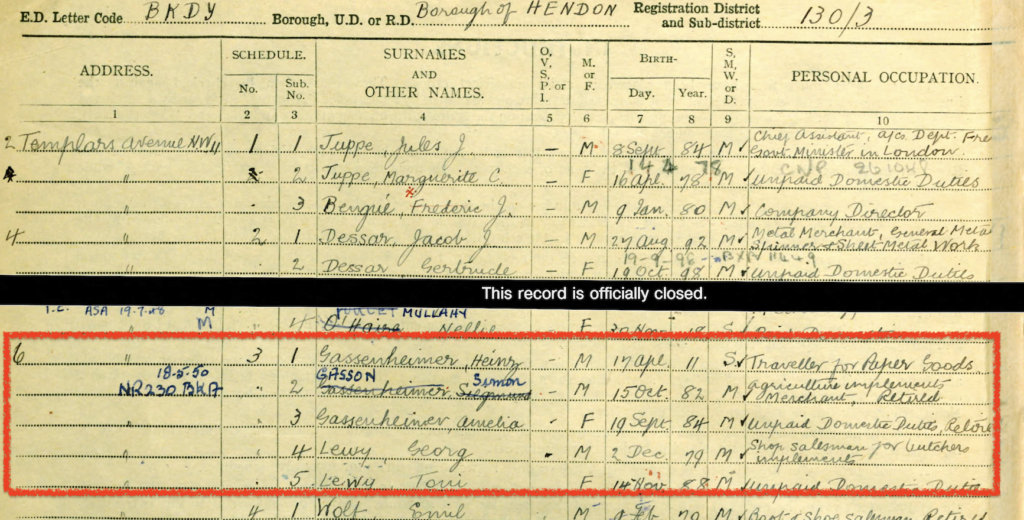
Declaration of war against Germany in September 1939 meant that all Germans in Britain were declared “enemy aliens” regardless of their religion or status as refugees from Nazi Germany. The Siegmund Gassenheimer family (as well as other members of the Gassenheimer family such as Siegmund’s nephew, Herbert, son of Ernst) needed to appear before Enemy Alien Tribunals to determine their status; in their meetings in late November 1939, they were all declared “exempt from internment.”
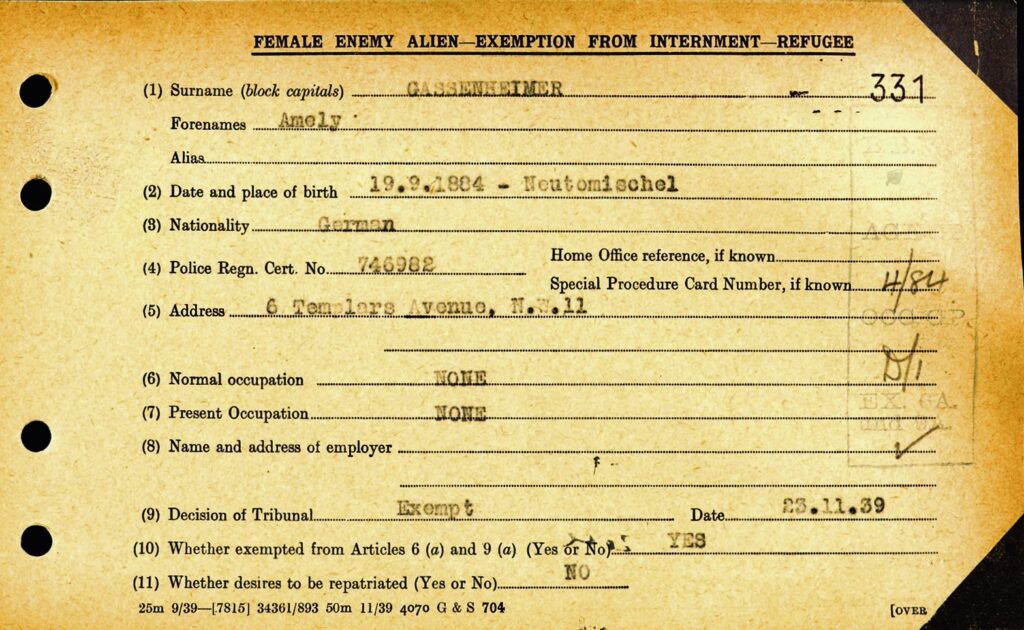
The German conquest of France in June 1940 changed that status: Siegmund and Heinz Gassenheimer were rounded up and interned; Siegmund was released a month later, Heinz in October 1940.
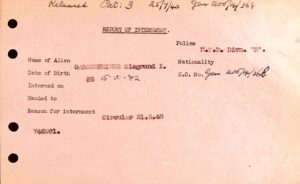
Herbert Lüdicke had the longest period of internment from June 1940 until 25 January 1941, possibly because he was not a Jewish refugee. However, he was not one of those deported either to Canada or Australia. During his internment, Barbara, first child of Herbert and Ilse, was born in September 1940.
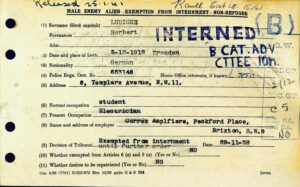
*****
The Holocaust shattered the first generation of the children of Samuel & Lotte Gassenheimer children, namely, the eight children who were still in Germany when Hitler came to power. Only one of Siegmund’s siblings — his older brother, Julius — was able to escape before the deportations of October 1941 began. On 24 March 1941, 72-year-old Julius and his 71-year-old wife, Johanna (née Joseph), received their visas to enter the United States. Sometime between April and June, they travelled in a sealed train from Berlin through France to Portugal; on 12 June 1941, they left on one of the last boats to leave Lisbon.
The other five — Ernst, Elise, Georg, Minna, and Rudolf, the latter three with spouses or ex-spouse — were all deported ‘east’: to Riga Ghetto, to Theresienstadt Ghetto, and several on to the Auschwitz Killing Centre from sent from the Theresienstadt Ghetto.
Minna Frankenberg, née Gassenheimer, survived the Holocaust. Freed from imprisonment in the Theresienstadt Ghetto, she returned to Halle/Saale where she had lived for so many years. Halle/Saale was sealed behind the Iron Curtain in the former DDR. Sadly, Siegmund, who died in 1957 in London, and his older sister Minna, who died in 1961 in Halle/Saale, never knew that the other was alive.
*****
- Siegmund GASSENHEIMER (later Simon GASSON), b. 15 Oct 1882 Themar, mid-July 1939 to England, d. 1957 London/England
- ∞ (13 Feb 1910 Neutomischel) Amelia “Mally” LEWY, b. 19 Sep 1884 Neutomischel/Posen, mid-July 1939 to England, d. 20 Feb 1980 London/England
- 1. Heinz Siegbert GASSENHEIMER (later Harold Steven GEARSON), b. 17 Apr 1911 Dresden, 1933 to England, d. 06 Jan 2000 Barnet/England
- ∞ (1) (Apr 1946) Marcelle GOFFIN
- 2. Margaret Evelyn GASSENHEIMER (later GEARSON), b. 12 Mar 1948 London/England, d. 1971 London/England, buried Hampstead cemetery
- ∞ (Oct 1969) Anthony R BARNETT
- 3. Julius Anthony BARNETT, b. Apr 1970 London/UK
- ∞ (2) (Jan 1953 London) Monica BODE, b. 11 Mar 1915 Dresden, 1952 fr Germany to England, d. 2006 London/England
- 2. John GEARSON
- ∞ Vanessa BEARD
- 3. Olivia GEARSON
- 3. Ana Maria GEARSON
- 1. Ilse GASSENHEIMER, b. 11 Jun 1914 Dresden, 1934 to England, d. 1998 England
- ∞ (Jul 1938) Herbert LÜDICKE (later LINDSAY), b. 03 Dec 1912 Dresden, to UK before WWII, 1940 interned/1941 released, d. 07 Apr 2008 Welwyn Garden City/England
- 2. Barbara LÜDICKE/LINDSAY, b. 30 Sep 1940
- ∞ (1) (1963) Martin BROWN
- 3. Miranda BROWN
- 3. Julian BROWN
- 3. Dominic BROWN
- ∞ (2) (Dec 1982) John MASON
- 2. Martin S. LÜDICKE/LINDSAY, b. MA 1949 London City/England
- ∞ (1970) Janice GRAHAM
- 3. Thomas LINDSAY
- 3. Daniel LINDSAY
- 2. Nicola LÜDICKE/LINDSAY, b. Jan 1954 Hampstead/England
We wish to thank the family of Siegmund’s granddaughter, Barbara Mason, and her daughter, who discovered this website in 2012, for their generosity in sharing information, images, and memories of their family.
Sources:
Family Papers & photographs
Email correspondence from B. Mason to Sharon Meen, 2012-2023
The National Archives; Kew, London, England; HO 396 WW2 Internees (Aliens) Index Cards 1939-1947; Reference Number: Ho 396/174 (Ancestry.com)
Ancestry.com.Germany, Select Births and Baptisms, 1558-1898 [database on-line]. Provo, UT, USA: Ancestry.com Operations, Inc., 2014.
Ancestry.com. England & Wales, Civil Registration Marriage Index, 1916-2005 [database on-line]. Provo, UT, USA: Ancestry.com Operations, Inc, 2010.